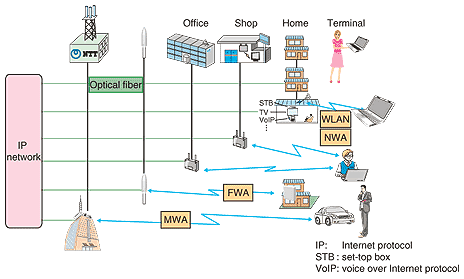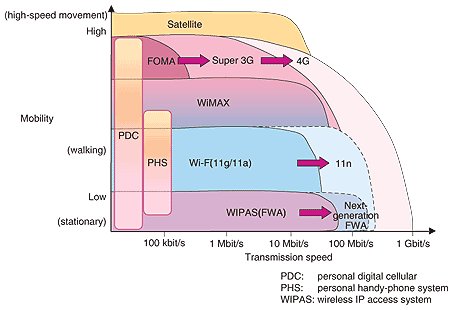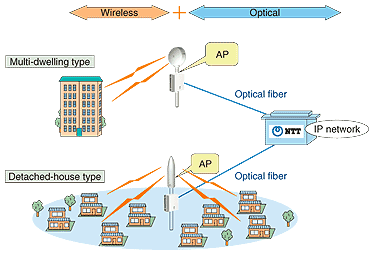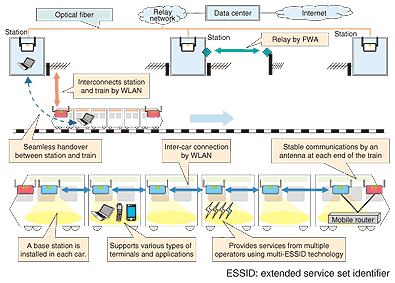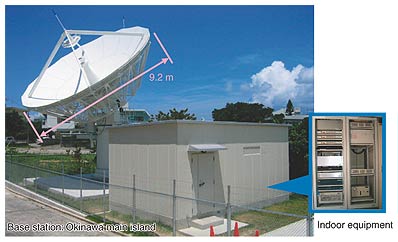 |
|||||
|
|
|||||
|
Special Feature: NTT Tsukuba Forum 2006 Workshop Lectures Vol. 5, No. 5, pp. 14–19, May 2007. https://doi.org/10.53829/ntr200705sf2  Trends in Wireless Access Systems Toward a Dramatic Expansion of FTTHAbstractThe increasingly diverse nature of information communications marks the beginning of a new era, and wireless systems are changing the spheres of communication activity. This article considers what types of fields could make effective use of wireless access technologies and how those technologies should be developed for the future and introduces several usage examples.
1. Trends in wireless access systems1.1 Transition in wireless systemsWireless systems have been used for some time in TV relay networks and other forms of relay circuits, but this type of application has been decreasing as optical fiber has been deployed in relay circuits. Since around 2000, however, wireless systems have been a major way to access circuits, as seen by the spread of cell phones and other mobile systems. 1.2 Types of wireless systemsWhile optical fiber has become a common means of providing access circuits to homes and offices, wireless access systems that connect to the terminal points of optical fiber have come to be classified into several categories according to the purpose of their use (Fig. 1). Wireless local area networks (WLANs) are used inside homes; nomadic wireless access (NMA) uses WLAN terminals in shops, offices, or other locations outside the home; fixed wireless access (FWA) provides access to a home by both optical and wireless means; and mobile wireless access (MWA) is used by cell phones. These methods all provide access to the IP (Internet protocol) network. For each of these systems, there are core fields according to the degree of mobility and transmission speed (Fig. 2). In the mobile field, the era of 4G (4th-generation communication systems) is close at hand as a successor to the FOMA (3G) and Super 3G eras. Technically speaking, 4G, which excels in both mobility and transmission speed, can be viewed as covering all services with the exception of satellite communications. On the other hand, each wireless system is allocated certain frequencies, and applications to be provided by each system are determined in advance. In short, frequencies are allocated for each service, but with the expansion of the wireless market and the rising demand for frequencies, some frequency bands are running out of available frequencies. There is also a limit to the frequencies that are expected to be allocated to 4G, and considering that the cell phone market currently stands at more than 90 million subscribers*, the application of 4G to other forms of communication besides mobile communications is not a realistic proposition. The use of frequencies—a finite resource—by wireless systems therefore requires us to consider how a limited range of frequencies can be effectively used. It can even be said that segregating wireless systems is important so that the frequencies allocated to each system can be more effectively used and services can be provided that make full use of the features of those frequencies.
1.3 Future role of wireless access systemsIn view of the above transition in wireless systems and system diversification, and considering that optical access will achieve sufficient penetration by 2010, we can expect wireless access systems to play a cooperative and supplementary role to optical access and mobile services. In particular, the following applications can be considered: (1) FWA could provide "optical + wireless" (co operation with optical access) (2) NWA could provide "optical + WLAN" (co operation with optical access) and "voice + Internet" (cooperation with mobile services) (3) Satellite communications could provide services in areas inaccessible by fiber (supplement to optical access) and services in areas outside mobile-service coverage (supplement to mobile services).
2. FWA system (WIPAS)2.1 WIPAS outline and usage examplesThe wireless IP access system (WIPAS) is an optical and wireless network system provided by NTT. The idea behind it is to provide inexpensive broadband services at an early date by combining both optical and wireless transmission. In WIPAS, optical cable connects an NTT central office with base stations and a radio signal connects base stations with points up to 700 m away. The wireless section uses the 26-GHz band, achieving a throughput of 46 Mbit/s. There are two types of WIPAS according to the installation format: multi-dwelling units and detached houses (Fig. 3).
(1) Multi-dwelling type This type targets users in apartment buildings, multi-purpose buildings, and the like, which are considered to be difficult to lay optical cables to. In general, B-FLET'S services can be provided by mounting an access point (AP), that is, a wireless base station, on a utility pole (joint or exclusive) and a wireless terminal (WT), that is, a subscriber station, on the wall of the building or on a balcony.
(2) Detached-house type This type targets rural areas (outside the range of optical expansion) and new housing developments. It features the installation of an AP-IFU (intermediate-frequency unit access point that connects to the optical cable) and AP-RFU (radio-frequency unit access point that communicates with the user) on a utility pole and a WT on the balcony or roof of the customer's house or even on a pole owned by the customer. The AP-RFU must be installed relatively high up to enable connection with all WTs in the service area. An installation height of about 16 m above the ground is typical in residential areas.
2.2 Future FWA developmentsAs a system that supplements either optical access or metallic-based systems, FWA should play an increasingly important role in the years to come. For this reason, it must be capable of providing B-FLET'S or equivalent services as a minimum standard. Specifically, its maximum transmission speed must be raised from the present 46 Mbit/s to the 200-Mbit/s level in order to provide triple-play services, i.e., Hikari Phone (IP-phone service), video, and Internet. Moreover, achieving a Class 4 quality of service (QoS) to support the Next Generation Network (NGN) and providing services to rural areas (expansion of service areas using microwave-based FWA) are issues of particular urgency that must be addressed. Future undertakings in this regard can be broadly divided into the following three types, based on the degree of optical conversion in a service area. (1) Complete optical area: Use FWA to provide triple-play services to apartment buildings and other forms of multi-dwelling complexes. (2) Incomplete optical area (ADSL): Use FWA to provide triple-play services to areas where ADSL (asymmetric digital subscriber line) experiences high loss and to areas that are not capable of providing ADSL after feed-point routers. (3) Non-optical area: Use FWA to provide Hikari Phone and Internet access using microwave-based FWA, with the aim of expanding the service area. 3. NWA system (WLAN)3.1 NTT's NWA systemNomadic wireless access aims to meet the needs of customers that want a broadband environment even outside the home. With NWA, a user that is carrying a home-use or office-use WLAN terminal while outside the home or office can access broadband services over a public WLAN system. In expanding NWA services, NTT is targeting places visited by an indefinite number of the general public where relatively long breaks can be taken such as train stations, airports, and coffee shops. NWA will enable users at such places to use services like content download, Internet access, e-mail, and file transfer. NTT-developed public WLAN services include "FLET'S SPOT" offered by NTT East and NTT West, "HOTSPOT" by NTT Communications, and "Mzone" by NTT DoCoMO. The construction of these platforms (base stations) is being handled by NTT Broadband Platform, Inc. (NTT-BP).
3.2 Future NWA developmentsFirst and foremost, it is essential that the NWA system achieve higher transmission speeds so that an Internet environment equivalent to that at home or in the office can be provided at outside locations and public gathering places. The present level of 54 Mbit/s is inadequate for this purpose and must be raised to over 100 Mbit/s. Ensuring security is also essential. Another possibility that has been raised for NWA is voice over IP (VoWiFi). In other words, the application of NWA should enable a user to carry a VoIP terminal for sending/receiving voice data out from the home or office for use at outside locations. Ensuring good call quality will be an important issue here. Discussions are now taking place at IEEE802.11-related standardization sites with the aim of improving the speed and quality of NWA. Standards that are expected to become important in this regard are 802.11n, which calls for communication speeds above 100 Mbit/s (scheduled for completion in 2008), 802.11e, which supports QoS in WLAN, and 802.11i, which prescribes security. Our plan is to introduce control technologies in conformance with such standards to ensure stable communication quality. For example, to cope with degradation in voice quality such as intermittent breaks and noise caused by an increasing number of terminals, admission control procedures will be implemented to control the number of terminals that can be simultaneously connected and prevent a drop in quality. Also, for multicast video delivery services, which are sensitive to delays and degradation, multicast priority control will be implemented to provide video in a prioritized manner. 4. Satellite communications systems4.1 Effective satellite communications for handling disasters and isolated islandsOne outstanding feature of satellite communications is its robustness to terrestrial disasters. At the time of the Great Hanshin-Awaji Earthquake, satellite communications systems played an active part in the stricken areas. Step-by-step improvements to this emergency system began to be made in 2006, following the tenth anniversary of this disaster in 2005. Base stations for disaster response with 4.5-m-diameter antennas are located in Tachikawa (eastern Japan) and Matsuyama (western Japan), and transportable 1.2-m-diameter antennas can be transported to stricken areas as needed. The plan is to make these transportable antennas even smaller and to provide even hand-held terminals in the future. A satellite communications system has also been used since 1983 to provide communications with isolated islands that cannot be reached by optical fiber. The present system was upgraded in 2005 and is now providing satellite-based communication services to three islands: Ogasawara, Iogashima, and Minamidaitojima. To provide communications between Minamidaitojima and the mainland, a large 9.2-m-diameter antenna was installed at both the base station on Okinawa and the island itself (Fig. 5). The use of a large antenna ensures good quality in the communication circuit by overcoming the problem of fading common to wireless systems.
4.2 Future developments in satellite communicationsTo achieve an even greater penetration of satellite communication services, the wide-area and disaster-response features of satellite communications must be used to the maximum. Expansion to extremely rural areas, as in the case of communications for isolated islands, can be achieved by utilizing this wide-area feature, which is capable of covering the whole of Japan. Satellite communications can also be an effective supplement for needs not covered by mobile services such as high-speed mobile communications and ocean-based communications. For example, the wide-area feature of satellite communications can be exploited to gather measurement data related to weather, landslides, water levels, and ocean conditions from sensors installed in places that do not have the communication infrastructure found in other parts of Japan. Such data gathering can make a significant contribution to achieving a safe and secure society. Satellite communications is also capable of providing broadband services for ships and high-speed mobile transport for which mobile services (2G, 3G, Super 3G, and 4G) cannot be easily provided. Systems for providing satellite-communication services for Japan's high-speed bullet trains and ships navigating Japan's economic waters are being considered. 5. ConclusionEven though the era of 30 million optical subscribers is only a few years away and the number of cell-phone subscribers has already broken the 90-million level, there are still areas and service formats that are not being covered. Based on the concept of using wireless access systems in a cooperative and supplementary role to optical access and mobile services, we aim to:
With this in mind, we will continue to develop and expand advanced wireless-access-system technologies. |
|||||








